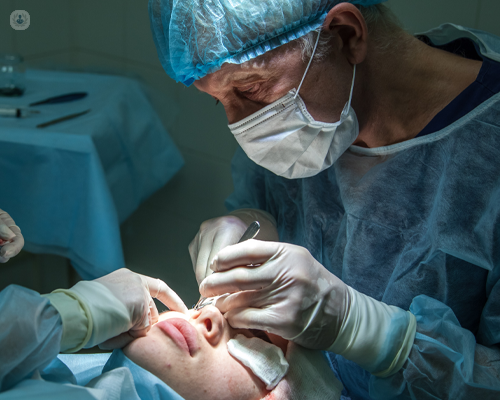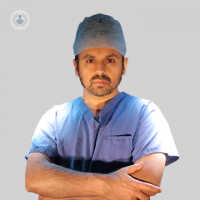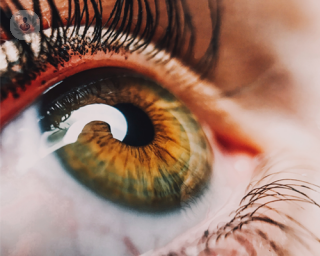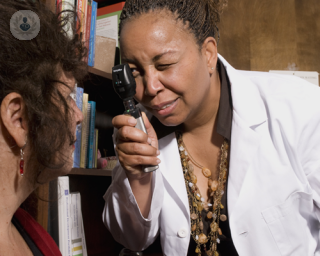Trabeculectomy
Mr Imran Masood - Ophthalmology
Created on: 04-28-2017
Updated on: 08-09-2023
Edited by: Conor Lynch
What is a trabeculectomy?
A trabeculectomy is a glaucoma operation usually done under local anaesthetic, via an injection beside the eye. It aims to reduce eye pressure caused by glaucoma, which can slowly damage - and even cause permanent loss of - eyesight, by draining fluid out of the eye.

Why would someone need a trabeculectomy?
The damage caused by glaucoma, which normally means there is a problem with pressure in the eye, is permanent. It means that you can slowly lose your eyesight and the higher the pressure, there is a greater chance of vision loss.
Eyesight cannot be made better by a trabeculectomy but it may reduce chances of it getting worse by reducing eye pressure.
How is a trabeculectomy done?
It is normally done under local anaesthetic. Once it takes effect, the operation is done to the white of the eye under the eyelid. A small flap, like a trapdoor, is made in this area, under which a little hole is cut to allow fluid to drain out of the eye. This flap is then sewn up with loose stitches, which should accommodate for fluid to continue to drain out of the eye so pressure on the eye is reduced. After this more sutures are put on the conjunctiva, or the thin 'skin' that covers the eyeball.
The drainage hole can sometimes be blocked by scar tissue that results from healing after the operation. Eye pressure can rise again if this is the case. A special chemical is often used during the operation, which can assist in stopping this excessive healing from occurring.
What are the risks involved in a trabeculectomy?
The risks involved in a trabeculectomy can be:
- An infection in the eye, known as endophthalmitis. It's very rare but can lead to loss of sight.
- Bleeding inside the eye
- Eye inflammation (inside)
- Eye and eyelid bruising, which settles after a few weeks.
- Allergies to medicine used.
Furthermore, you should contact your hospital immediately if you have any of the following:
- Excessive pain
- Vision loss
- Redness of the eye that increases
- Sticky eye discharge
What's involved in preparation for a trabeculectomy?
Before the day of your operation, you will need to attend a pre-operative assessment to ensure you are in good health and well enough to have the operation. This assessment will include:
- Questions about your general health
- Blood tests
- An ECG (Electrocardiogram)
Measurements of your eyes will also be taken.
Your doctor will also need to know about any medication you are taking, alongside any allergies or things you may be sensitive to. You will also be advised on specific pre-operative preparations you need to make.
A trabeculectomy is normally carried out as an overnight stay.
What happens after a trabeculectomy?
While you are in hospital, on the following day of your operation, the dressing will be removed. This allows the doctor to examine your eye, where pressure and stitches will be checked. Most patients are allowed home the day after the operation.
Your eye will feel scratchy because of the wound and stitches. Your sight will likely to be blurry up to three weeks, but it should settle to a similar level to that before the operation. Prescription for glasses may need to change but it's best to wait for around three months to go ahead with this.
The eye drops you use in the operated eye will need to change. You will need to start using steroid eye drops, antibiotic eye drops and dilating eye drops instead of glaucoma drops. You should continue to use any glaucoma drops you were using previously in the other eye. Your specialist will provide you with specific instructions about exactly how many drops to administer for each type of eye drops.
You will also need to visit a post-operative glaucoma clinic. Stitches may need adjusting, your consultant may need to give injections close to the operation site in order to help the eye settle down. If either of these need to be done, anaesthetic drops will be used to numb the eye first.
You may have to go back for further surgery if you need more extensive treatment. Reasons for this can include:
- The trabeculectomy is over-draining and the eye pressure is too low so more sutures may be needed in the trapdoor flap.
- Also, if the conjunctival wounds are leaking then more sutures may be needed.
- The trapdoor flap may need to be revised or opened up more if the trabeculectomy is under-draining and the eye pressure hasn't come down.
At some point after the operation, your consultant will need to aid the flow of fluid out of the eye using different methods. This is known as 'bleb manipulation'. The different methods to do this can be:
- Stitch adjustment or removal
- Eye massage to open up the trapdoor flap
- Injection of anti-scarring drugs
When a manipulation is done, you need to stay in the clinic for most of the morning or afternoon, depending on the time.
Which specialist performs a trabeculectomy?
Ophthalmologists, who are specially trained in eye care, perform trabeculectomy operations.














